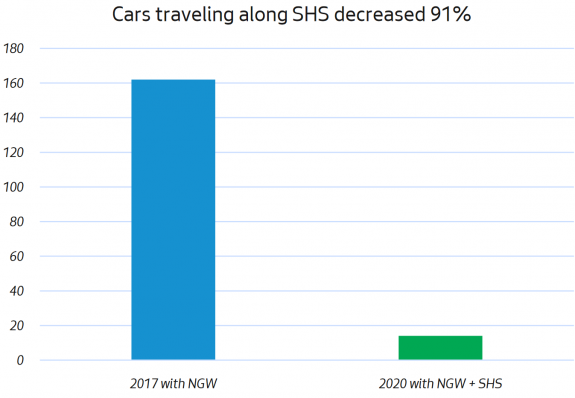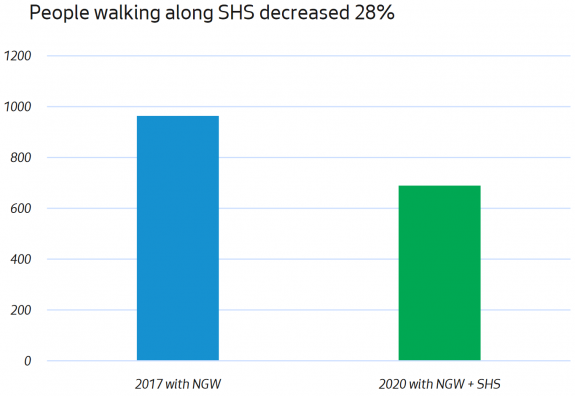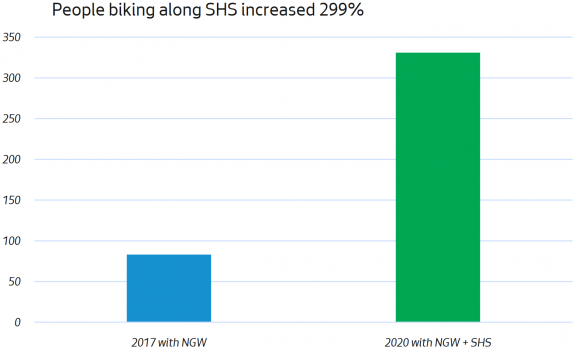 It made national news last week when Seattle announced that the Stay Healthy Streets (“SHS”) program would be transitioning from an emergency program to a permanent program. For example, a CNN headline read: “Seattle to permanently close 20 miles of streets to traffic so residents can exercise and bike on them.”
It made national news last week when Seattle announced that the Stay Healthy Streets (“SHS”) program would be transitioning from an emergency program to a permanent program. For example, a CNN headline read: “Seattle to permanently close 20 miles of streets to traffic so residents can exercise and bike on them.”
And yes, the Stay Healthy Streets are great. But I think some people may be a bit confused about what “closed” actually means here. Local traffic is still allowed, including deliveries, service vehicles and people accessing homes. And, of course, they only work so long as people choose to follow the rules. There is no physical barrier preventing someone from driving through, though that may be something the city should consider for some locations if the voluntary method does not work.
But at least so far, the signs alone have been very successful. Traffic volumes are down 91% on the Central District SHS compared to 2017 levels after the neighborhood greenway was installed. That 91% decrease far outpaces the the 57% decrease in overall car traffic since the outbreak began, a sign that the signs are working.

 SDOT also found that the number of cars turning onto the SHS was down 80%, suggesting that people are mostly using the streets as intended: Turning down just the block they need to use and using a different street when possible.
SDOT also found that the number of cars turning onto the SHS was down 80%, suggesting that people are mostly using the streets as intended: Turning down just the block they need to use and using a different street when possible.
And biking was way up on the street, nearly tripling the 2017 count. And that’s without a lot of commute trips, suggesting that a ton of people are using bikes just to get out of the house and get some exercise or fresh air.
The number of people walking on the street decreased 28%, likely due to the decrease in commuting and transit use. However, the walking decrease was much lower than the driving decreases both citywide and on this street, so the SHS is still likely attracting people on foot. If anything, this number shows you just how effective the project has been at attracting people on bikes.
 And, of course, it’s hard to say what success looks like for this program just by looking at charts. During the outbreak, the goal is to provide people with more space to walk and bike without getting in each other’s 6-foot bubbles. So you want them to serve people, but not so many people that they get too crowded. I would say they are hitting that confusing target so far.
And, of course, it’s hard to say what success looks like for this program just by looking at charts. During the outbreak, the goal is to provide people with more space to walk and bike without getting in each other’s 6-foot bubbles. So you want them to serve people, but not so many people that they get too crowded. I would say they are hitting that confusing target so far.
But the streets are not only serving a purpose during the outbreak, they are also wise neighborhood greenway improvements for the future. That’s the way Mayor Jenny Durkan sees it.
“We are in a marathon and not a sprint in our fight against COVID-19,” said Mayor Durkan in a blog post. “As we assess how to make the changes that have kept us safe and healthy sustainable for the long term, we must ensure Seattle is rebuilding better than before. Safe and Healthy Streets are an important tool for families in our neighborhoods to get outside, get some exercise and enjoy the nice weather. Over the long term, these streets will become treasured assets in our neighborhoods.”
SDOT staff gave a presentation to the virtual Seattle Bicycle Advisory Board (PDF) last week, and they said the city is looking into their options for installing more permanent and durable signage and barriers. The city has also officially run out of Road Closed signs, so they will need to buy them going forward. And that means the program will have more costs associated with it.
Another important side note: The city is using “Road Closed” signs because that is the legal designation under state law that they need to use in order to legally allow people to walk in the street. Some people biking have said they avoided the streets because they thought “Road Closed” also applied to bikes. The city is adding more clarifying signage to make it clear, reading, “Street open for people to walk, roll, bike, run and skate. Local access & deliveries OK.”
Seattle Neighborhood Greenways has been working to gather community ideas for Stay Healthy Streets and encourage the city to install more of them. They recently put out a map of 130 miles of streets that they say could be a SHS or have a temporary walking and biking path installed. Cascade Bicycle Club has also noted them as one of its advocacy priorities amid the outbreak. Paul Tolmé wrote a story for the Cascade blog touring some of the Stay Healthy Streets and interviewing people using them.









Comments
5 responses to “Car driving is down 91% from pre-outbreak levels on the city’s new Stay Healthy Streets”
I think the “closed” streets are a great idea. I sent email to Seattle Times Traffic Lab. Here’s most of what I sent:
First, let’s go back about 30 years or so. Several intersections on capitol hill and, perhaps, elsewhere where partially blocked, making through traffic by cars and trucks not possible. In the cases I’m thinking of, the blockage is not a dead end, but instead forces a right turn. This approach doesn’t prevent traffic from using the street but it makes it impractical to use, people learn that and avoid the street unless they have a reason to be there.
Now, I don’t know why so few were built, though I’ll postulate that it’s because the fire department didn’t like them. Instead, we got traffic circles. I got one at the intersection near my house. They are very helpful but they don’t, by any means, reduce through traffic.
The second point I am proposing is based on a comparison to suburban subdivisions. There, it’s typical that a large tract of land will have one road entering it that branches out where each branch is ultimately a dead end. What this does to traffic is keep it on the arterials. There’s no point of driving into the subdivision unless you are living or doing something there. See the similarity ?
Let me go on, though. Seattle has a better opportunity than the suburbs. We can create dead end streets all over the place but still let peds and bikes through. The suburbs generally can’t do that. We get the best of both – better pedestrian oriented streets and less through traffic. I’m so excited to see this concept revisited.
I would like to see the city take this far more aggressively. Find a solution that works with the fire department, assuming that was the prior point of resistance, and put dead ends or detours all over the city – thousands of them. Clearly this will take some work: outreach, planning, cost, and more. But it will be worth it !
This is great, and something we definitely need more of.
Hopefully, Google Maps treats the stay healthy streets as closed. Otherwise, everybody that’s a slave to their phone is going to be cutting through, sign or no sign.
I wonder if it’s even possible to set up virtual street closures, that are respected by the navigation apps, but avoid the expense of physical signage. That would allow it to scale a lot.
Google Maps is showing the streets as closed, which is helpful.
I am shocked so many people would drive on these narrow streets in the first place. I avoid them as much as possible when driving, except to get to the nearest arterial in the direction I’m going. Even if Google Maps suggests they are faster, I find that does not account for the high likelihood of getting stuck behind a garbage or delivery truck.
Great story Tom. While public response seems to be overwhelmingly in favor, I encountered an episode of vandalism while touring a Stay Health Street in West Seattle, where I met a neighbor retrieving a Street Closed sign and orange cone from the bushes where they had been, she said, thrown into the brambles by an angry person driving a truck. Hopefully an isolated incident, wondering if you’ve heard of other reports.
“The city is using “Road Closed” signs because that is the legal designation under state law that they need to use in order to legally allow people to walk in the street.” Sounds like a law that needs to be changed, then. Can we petition the legislature to allow people to walk in “Local Access Only” streets?